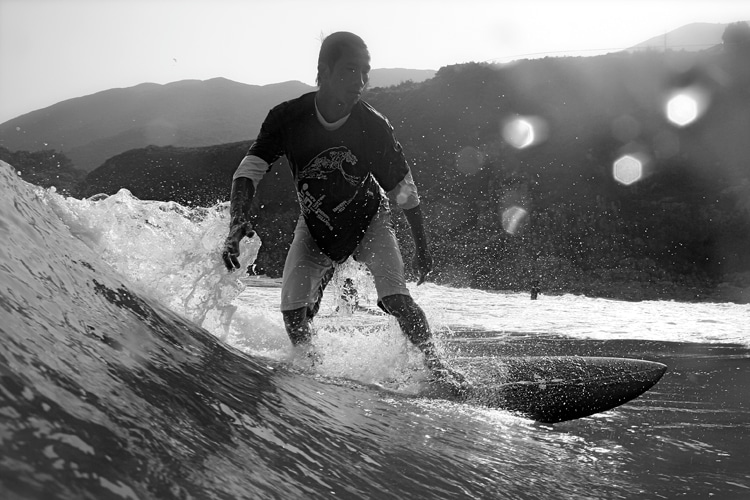Hong Kong imposes controversial surfing ban

Hong Kong is a city known for its mix of tradition and modernity.
However, China's special administrative region has taken a surprisingly rigid stance on surfing by enforcing a full-on ban across all 42 public beaches managed by the Leisure and Cultural Services Department (LCSD).
Twelve of the territory's beaches are situated on Hong Kong Island, while the other 30 are spread across the New Territories, including the Outlying Islands.
The policy has existed for decades but has recently been under the spotlight due to intensified enforcement and growing frustration among surfers.
The Origin of the Ban
The surfing ban in Hong Kong is not new. It dates back to when the LCSD implemented regulations to ensure safety at public beaches.
Officially, the law prohibits any person from bringing or using surfboards in areas designated for swimming.
The government argues that surfboards pose a safety risk to swimmers and first responders, especially during dangerous weather conditions.
Despite this, the ban was historically quietly enforced, allowing surfers to enjoy Hong Kong's limited but precious waves, particularly at Big Wave Bay, the only beach on Hong Kong Island with rideable surf.
Surf bans are not new in Asia and around the world. Foils, for instance, are getting more and more no-go warnings at select international beaches.
In some Southern California coastal communities, there's even a sign that tells surfers to stay away from the water.
It's called the black ball flag, and it's raised to protect beachgoers from getting hit by surfboards in the swimming zone during summer.
Recent Enforcement and Public Backlash
However, the Hong Kong authorities made sure to push the new rule further and strongly enforce it this year.
In May 2023, new laws were introduced targeting risky watersports during typhoons and rough seas, leading to the installation of "No Surfing" signs at all LCSD beaches by June.
Violators now face severe penalties, including fines of up to HK $2,000 (approximately $260 USD) and up to 14 days in jail.
Recent incidents include the prosecution of two surfers caught at Big Wave Bay during a typhoon, a decision that breaks away from the prior informal understanding between surfers and authorities.
It's not easy to be a surfer in a city that is home to 7.5 million people.
Why Now?
Critics are questioning the timing of the crackdown.
Lawmaker Adrian Pedro Ho King-hong from the New People's Party has taken up the cause, repeatedly pushing for a dialogue with the Culture, Sports and Tourism Bureau (CSTB).
His proposals for compromise, such as designated surfing zones or restricted wave-riding hours - have been dismissed outright.
According to Ho, officials rejected the idea, citing fears of public complaints.
The LCSD has stated it has no plans to amend the rules or conduct feasibility studies, maintaining that surfing "has always been prohibited" at LCSD-managed beaches.
Impact on Hong Kong's Surfing Scene
The ban has hit Hong Kong's surfing community hard.
Big Wave Bay now faces a dark future despite its long history and tradition as the hub of the city's surf culture.
Local surfers and instructors expressed confusion and frustration and complained about the lack of clear communication from authorities.
For many, the government's heavy-handed approach feels disproportionate, especially in a city renowned for its cultural diversity.
The ban also puts Hong Kong at odds with the rise of surfing worldwide as a water sport.
While other countries are investing in infrastructure and even hosting Olympic qualifying events, Hong Kong's conservative stance effectively excludes its surfers from participating in and hosting contests in the territory.
Calls for Change
Despite the setbacks, efforts to fight the ban continue.
Ho has urged the government to rethink its position, emphasizing that with 42 beaches under LCSD management, it should be possible to allocate at least one for surfing.
He also advocates for public consultations or surveys to gather broader opinions rather than assuming universal opposition.
Meanwhile, local surfers and journalists keep expressing the lack of rationale behind the enforcement and the need for balanced regulations that can accommodate both swimmers and water sports enthusiasts.
The editorial board of the South China Morning Post echoed these sentiments, arguing that many countries successfully manage shared beach use.
They called on the government to find a solution that ensures safety for beachgoers without outright banning a sport that is surely increasingly popular.
When in Doubt, Don't Paddle Out
The surfing ban is a symbol of the broader tensions within Hong Kong.
It underscores the city's increasing alignment with rigid mainland policies, prioritizing control over compromise.
While the CSTB appears unyielding, the surfers' fight continues with hope for a more inclusive future, especially at Big Wave Bay.
If the government maintains its current position, Hong Kong risks alienating not only its local surfing community but also potential visitors drawn by the South China Sea swells.
The question remains: will public pressure and persistent advocacy be enough to turn the tide?
Surfing is not a crime.
Words by Luís MP | Founder of SurferToday.com
